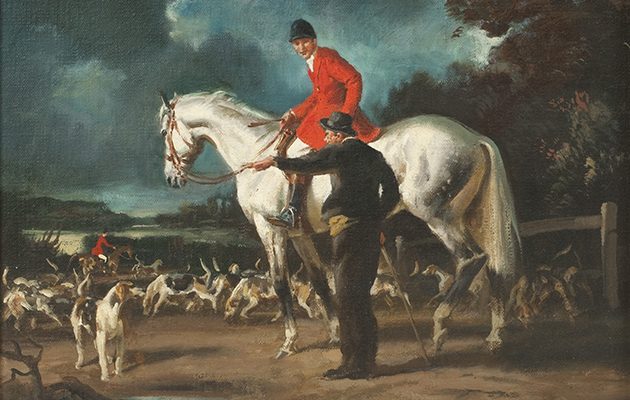Raoul Millais came from a family adept at capturing the spirit of the age on canvas. It is time his work was re-evaluated, suggests Janet Menzies
Four generations of the Millais family captured to spirit of the period on canvas. Raoul Millais may not have been in the mainstream of sporting art but it is time his work was re-evaluated, suggests Janet Menzies.
For more sporting artists, Bruce Little’s much-larger-than-life bronze lion sculpture is now safely installed in Longleat after a torturous journey from South Africa. And Daniel Crane’s enthusiasm for hunting infuses his paintings.
RAOUL MILLAIS
When your grandfather was a founder member of the Pre-Raphaelite Brotherhood and created such famous works as Christ in the House of His Parents and Ophelia, surely it’s hard to make your mark as an artist? The Millais family seems to have had no problem with this, with each succeeding generation adding to the Millais mythology.

The End of a Grand Day, oil on canvas.
Raoul Millais, grandson of Sir John Everett Millais, was born near Horsham, West Sussex, in 1901. Millais painted hunters and hunting, racehorses, matadors and their bulls, big-game hunting and all the glamorous and beautiful people engaged in sport. To capture that life, Millais required to live it. He was a contemporary of Ernest Hemingway
and spent time with the writer in Spain, where he sketched the corrida, a shared love. His father, John Guille “Johnny” Millais, a naturalist writer and painter, took him to Africa in his twenties – a trip that saw him walk 2,500 miles and shoot his first Cape buffalo. And, of course, Millais hunted. He confessed: “I managed to persuade the taxman that to keep three horses and pay a groom’s wages and a hunt subscription were essential to my profession as a painter, which indeed they were. So the proceeds from my pictures made enough money to buy and keep horses.”
One of Millais’s sons, the late Hugh Millais, filled an action-packed life with adventuring, acting and generally looking smoulderingly handsome. Hugh eventually went to Cuba and immediately got shot, necessitating a rescue by Hemingway. Millais admitted: “I don’t know what poor Hughie does. He cannot… even draw a salary.”

Pastel drawing titled Hagenbach Circus, at Horsham Gallery.
So four generations of the Millais family lived life at the hub of their times, their creative work epitomising the spirit of the period. Jeremy Knight is heritage and museum manager at the Horsham Museum & Art Gallery, where he curates the Raoul Millais collection. Knight emphasises the social narrative of Millais’s work: “He painted not just the sport but the people. I love one of his paintings in our collection of a fashionable lady walking in her Edwardian clothes. I describe his work as more art of the field than conventional sporting art. He has a broad spectrum of subject matter and always with this sensitivity to the atmosphere of what life was like.”
Antique dealer and sporting art collector Clifford Hall agrees that Millais captures the whole sporting moment, especially with hunting. “I love the energy of his work and even more the knowing look in the eye of his subject – equine or human.”
TIME TO RE-EVALUATE

Oil painting of a woman riding sidesaddle, dated 19 August 1983.
During his lifetime, he appealed to a coterie of friends and sporting acquaintances who collected him. Knight explains: “In his day, people who knew him collected him but he didn’t have the high profile of someone like Munnings even then. Today, I think he has been forgotten about somewhat, perhaps because he wasn’t quite in the mainstream of sporting art. He painted a whole panoply of scenes, whether it was Spanish ladies, elegant society people at the races or even big game in Africa. We have a painting I love of a circus horse, for example. He was passionate about depicting animal life in a broad spectrum. I think it is definitely time for people to start looking at Millais again and re-evaluating his work.”

Oil painting titled The Pageant, 1936.
Jamie Rountree, of London’s Rountree Tryon Galleries, agrees with Knight that Millais had a wide range. “Millais exhibited twice with the Tryon Gallery, once in Dover Street in 1973 and then in Cork Street in 1982. He was a fine horseman as well as a quite brilliant draughtsman, especially when painting his beloved animal subjects. Horses in particular he seemed to be born to depict. What is more surprising is quite how versatile Millais was, with inspiration ranging from hunting in Leicestershire, his African trips in his early twenties through to his later love of Andalusia. Above all, his paintings reflect a dramatic romanticism, with patches of light and shadow predominant, highlighting a specific focus of his work whether that be bullfighting, stalking, shooting, fishing, driving, racing, hunting, skiing or the ballet.”
When Millais’s work does occasionally come up at auction, it is often affordable – though you may have to bid against Knight looking to add to the Horsham collection.
View the Raoul Millais collection at Horsham Museum & Art Gallery, West Sussex RH12 1HE. For details, call 01403 254959 or go to: www.horshammuseum.org
For the Rountree Tryon Galleries, go to: www.rountreetryon.com





